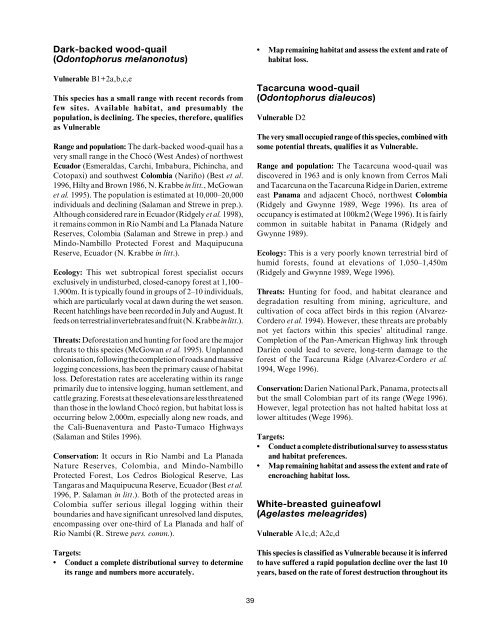Partridges, Quails, Francolins, Snowcocks, Guineafowl, and Turkeys
Partridges, Quails, Francolins, Snowcocks, Guineafowl, and Turkeys
Partridges, Quails, Francolins, Snowcocks, Guineafowl, and Turkeys
You also want an ePaper? Increase the reach of your titles
YUMPU automatically turns print PDFs into web optimized ePapers that Google loves.
Dark-backed wood-quail<br />
(Odontophorus melanonotus)<br />
Vulnerable B1+2a,b,c,e<br />
This species has a small range with recent records from<br />
few sites. Available habitat, <strong>and</strong> presumably the<br />
population, is declining. The species, therefore, qualifies<br />
as Vulnerable<br />
Range <strong>and</strong> population: The dark-backed wood-quail has a<br />
very small range in the Chocó (West Andes) of northwest<br />
Ecuador (Esmeraldas, Carchi, Imbabura, Pichincha, <strong>and</strong><br />
Cotopaxi) <strong>and</strong> southwest Colombia (Nariño) (Best et al.<br />
1996, Hilty <strong>and</strong> Brown 1986, N. Krabbe in litt., McGowan<br />
et al. 1995). The population is estimated at 10,000–20,000<br />
individuals <strong>and</strong> declining (Salaman <strong>and</strong> Strewe in prep.).<br />
Although considered rare in Ecuador (Ridgely et al. 1998),<br />
it remains common in Río Nambí <strong>and</strong> La Planada Nature<br />
Reserves, Colombia (Salaman <strong>and</strong> Strewe in prep.) <strong>and</strong><br />
Mindo-Nambillo Protected Forest <strong>and</strong> Maquipucuna<br />
Reserve, Ecuador (N. Krabbe in litt.).<br />
Ecology: This wet subtropical forest specialist occurs<br />
exclusively in undisturbed, closed-canopy forest at 1,100–<br />
1,900m. It is typically found in groups of 2–10 individuals,<br />
which are particularly vocal at dawn during the wet season.<br />
Recent hatchlings have been recorded in July <strong>and</strong> August. It<br />
feeds on terrestrial invertebrates <strong>and</strong> fruit (N. Krabbe in litt.).<br />
Threats: Deforestation <strong>and</strong> hunting for food are the major<br />
threats to this species (McGowan et al. 1995). Unplanned<br />
colonisation, following the completion of roads <strong>and</strong> massive<br />
logging concessions, has been the primary cause of habitat<br />
loss. Deforestation rates are accelerating within its range<br />
primarily due to intensive logging, human settlement, <strong>and</strong><br />
cattle grazing. Forests at these elevations are less threatened<br />
than those in the lowl<strong>and</strong> Chocó region, but habitat loss is<br />
occurring below 2,000m, especially along new roads, <strong>and</strong><br />
the Cali-Buenaventura <strong>and</strong> Pasto-Tumaco Highways<br />
(Salaman <strong>and</strong> Stiles 1996).<br />
Conservation: It occurs in Río Nambí <strong>and</strong> La Planada<br />
Nature Reserves, Colombia, <strong>and</strong> Mindo-Nambillo<br />
Protected Forest, Los Cedros Biological Reserve, Las<br />
Tangaras <strong>and</strong> Maquipucuna Reserve, Ecuador (Best et al.<br />
1996, P. Salaman in litt.). Both of the protected areas in<br />
Colombia suffer serious illegal logging within their<br />
boundaries <strong>and</strong> have significant unresolved l<strong>and</strong> disputes,<br />
encompassing over one-third of La Planada <strong>and</strong> half of<br />
Río Nambí (R. Strewe pers. comm.).<br />
Targets:<br />
• Conduct a complete distributional survey to determine<br />
its range <strong>and</strong> numbers more accurately.<br />
• Map remaining habitat <strong>and</strong> assess the extent <strong>and</strong> rate of<br />
habitat loss.<br />
Tacarcuna wood-quail<br />
(Odontophorus dialeucos)<br />
Vulnerable D2<br />
The very small occupied range of this species, combined with<br />
some potential threats, qualifies it as Vulnerable.<br />
Range <strong>and</strong> population: The Tacarcuna wood-quail was<br />
discovered in 1963 <strong>and</strong> is only known from Cerros Mali<br />
<strong>and</strong> Tacarcuna on the Tacarcuna Ridge in Darien, extreme<br />
east Panama <strong>and</strong> adjacent Chocó, northwest Colombia<br />
(Ridgely <strong>and</strong> Gwynne 1989, Wege 1996). Its area of<br />
occupancy is estimated at 100km2 (Wege 1996). It is fairly<br />
common in suitable habitat in Panama (Ridgely <strong>and</strong><br />
Gwynne 1989).<br />
Ecology: This is a very poorly known terrestrial bird of<br />
humid forests, found at elevations of 1,050–1,450m<br />
(Ridgely <strong>and</strong> Gwynne 1989, Wege 1996).<br />
Threats: Hunting for food, <strong>and</strong> habitat clearance <strong>and</strong><br />
degradation resulting from mining, agriculture, <strong>and</strong><br />
cultivation of coca affect birds in this region (Alvarez-<br />
Cordero et al. 1994). However, these threats are probably<br />
not yet factors within this species’ altitudinal range.<br />
Completion of the Pan-American Highway link through<br />
Darién could lead to severe, long-term damage to the<br />
forest of the Tacarcuna Ridge (Alvarez-Cordero et al.<br />
1994, Wege 1996).<br />
Conservation: Darien National Park, Panama, protects all<br />
but the small Colombian part of its range (Wege 1996).<br />
However, legal protection has not halted habitat loss at<br />
lower altitudes (Wege 1996).<br />
Targets:<br />
• Conduct a complete distributional survey to assess status<br />
<strong>and</strong> habitat preferences.<br />
• Map remaining habitat <strong>and</strong> assess the extent <strong>and</strong> rate of<br />
encroaching habitat loss.<br />
White-breasted guineafowl<br />
(Agelastes meleagrides)<br />
Vulnerable A1c,d; A2c,d<br />
This species is classified as Vulnerable because it is inferred<br />
to have suffered a rapid population decline over the last 10<br />
years, based on the rate of forest destruction throughout its<br />
39

















